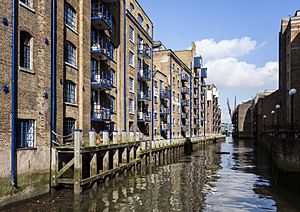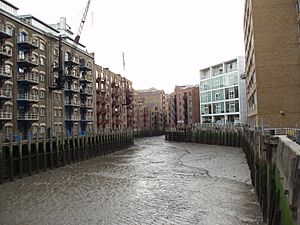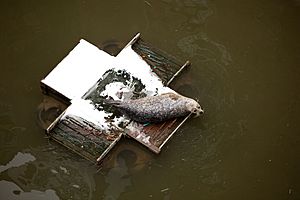St Saviour's Dock facts for kids

St Saviour's Dock is a special water inlet in London, England. It's on the south side of the River Thames, not far from Tower Bridge. Think of it like a small arm of the river reaching inland. This dock is at the end of a riverside path called Shad Thames. On its eastern side, you'll find a place called Jacob's Island.
Where is St Saviour's Dock?
The River Thames here has strong tides. This means the water level in the dock changes a lot. It can rise and fall by about four metres! This happens because of things like Teddington Lock and the Thames Barrier. These structures help control the river's flow. Sometimes, during very high tides, the water can even reach the sidewalks next to the dock. The dock itself is shaped like a rectangle. It opens up to the main river about 420 metres east of Tower Bridge.
St Saviour's Dock is also where a hidden river, the River Neckinger, joins the Thames. The Neckinger is a river that flows underground for most of its journey. It starts in the southern part of Southwark, near Walworth, and travels beneath the city before reaching the Thames at this dock.
A Look at History
A long time ago, starting in 1082, a group of monks lived near this area. They were called Cluniac monks and lived at Bermondsey Abbey. These monks started to develop the marshy land around their abbey. They made the land better for farming and built walls along the riverside. This created a large area of meadow.
They also dug ditches to manage the water. The monks turned the nearby tidal inlet, where the River Neckinger met the Thames, into their own dock. They named it Saint Saviour's Dock, after their abbey's patron saint. This dock was very important. It gave bishops and traders a safe place to land their boats. It was much easier than trying to get past the busy London Bridge, which was the main crossing point at the time.
John Stow, a historian from the 1500s, wrote about this area. He said: "In the south end whereof was sometime a priory or abbey of St. Saviour, called Bermond's Eye in Southwark, founded by Alwin Childe, a citizen of London, in the year 1081."



